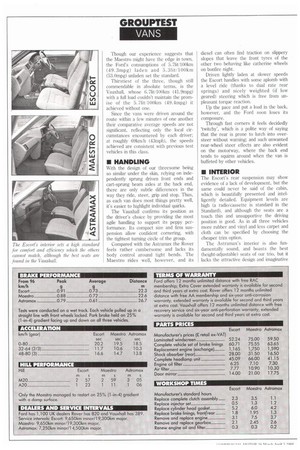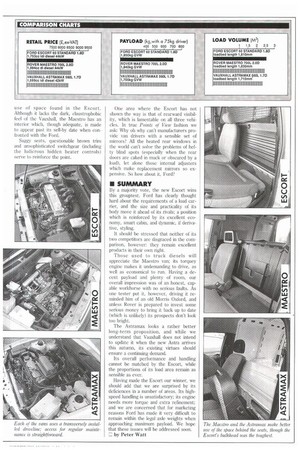GROUPTEST VANS
Page 34

Page 35

If you've noticed an error in this article please click here to report it so we can fix it.
Though our experience suggests that the Maestro might have the edge in town. the Ford's consumptions of 5.71it/100km (49.3mpg) laden and 5.31it/100km (53.0mpg) unladen set the standard.
Thirstiest of the three, though still commendable in absolute terms, is the Vauxhall, whose 6.71itilOOkm (41.9mpg) with a full load couldn't maintain the promise of the 5.71it/100km (49.4mpg) it achieved without one.
Since the vans were driven around the route within a few minutes of one another their comparative average speeds are not significant, reflecting only the local circumstances encountered by each driver; at roughly 69km/h (43mph), the speeds achieved are consistent with previous test vehicles in this class.
With the design of our threesome being so similar under the skin, relying on independently sprung driven front ends and cart-sprung beam axles at the back end, there are only subtle differences in the way they ride, steer, grip and stop. Thus, as each van does most things pretty well, it's easier to highlight individual quirks.
The Vauxhall confirms its position as the driver's choice by providing the most agile handling to support its peppy performance. Its compact size and firm suspension allow confident cornering, with the tightest turning circle of the group.
Compared with the Astramax the Rover feels rather cumbersome and lacks its body control around tight bends. The Maestro rides well, however, and its diesel can often find traction on slippery slopes that leave the front tyres of the other two behaving like catherine wheels on bonfire night.
Driven lightly laden at slower speeds the Escort handles with some aplomb with a level ride (thanks to dual rate rear springs) and nicely weighted (if low geared) steering which is free from unpleasant torque reaction.
Up the pace and put a load in the back, however, and the Ford soon loses its composure.
Through fast corners it feels decidedly 'twitchy', which is a polite way of saying that the rear is prone to lurch into oversteer without warning; and such unwanted rear-wheel steer effects are also evident on the motorway, where the back end tends to squirm around when the van is buffeted by other vehicles.
The Escort's rear suspension may show evidence of a lack of development, but the same could never be said of the cabin, which is beautifully presented and intelligently detailed. Equipment levels are high (a radio/cassette is standard in the Standard), and although the seats are a touch thin and unsupportive the driving position is good. As in all three vehicles more rubber and vinyl and less carpet and cloth can be specified by choosing the cheaper trim option.
The Astramax's interior is also fundamentally sound, and boasts the best (height-adjustable) seats of our trio, but it lacks the attractive design and imaginative use of space found in the Escort. Although it lacks the dark, claustrophobic feel of the Vauxhall, the Maestro has an interior which, though adequate, is made to appear past its sell-by date when confronted with the Ford.
Saggy seats, questionable brown trim and unsophisticated switchgear (including the ludicrous hidden heater controls) serve to reinforce the point.
One area where the Escort has not shown the way is that of rearward visibility, which is lamentable on all three vehicles. In true Points of View fashion we ask,: Why oh why can't manufacturers provide van drivers with a sensible set of mirrors? All the heated rear windows in the world can't solve the problems of hefty blind spots (especially when the rear doors are caked in muck or obscured by a load), let alone those internal adjusters which make replacement mirrors so expensive. So how about it, Ford?
By a majority vote, the new Escort wins this grouptest. Ford has clearly thought hard about the requirements of a load carrier, and the size and practicality of its body move it ahead of its rivals; a position which is reinforced by its excellent economy, smart cabin, and dynamic, if derivative, styling.
It should be stressed that neither of its two competitors are disgraced in the comparison, however: they remain excellent products in their own right.
Those used to truck diesels will appreciate the Maestro van; its torquey engine makes it undemanding to drive, as well as economical to run. Having a decent payload and plenty of room, our overall impression was of an honest, capable workhorse with no serious faults. As one tester put it, however, driving it reminded him of an old Morris Oxford, and unless Rover is prepared to invest some serious money to bring it back up to date (which is unlikely) its prospects don't look too bright.
The Astramax looks a rather better long-term proposition, and while we understand that Vauxhall does not intend to update it when the new Astra arrives this autumn, its existing virtues should ensure a continuing demand.
Its overall performance and handling cannot be matched by the Escort, while the proportions of its load area remain as sensible as ever.
Having made the Escort our winner, we should add that we are surprised by its deficiences in a number of areas. Its highspeed handling is unsatisfactory; its engine needs more torque and extra refinement; and we are concerned that for marketing reasons Ford has made it very difficult to remain within the legal axle weights when approaching maximum payload. We hope that these issues will be addressed soon.
by Peter Watt
















































































